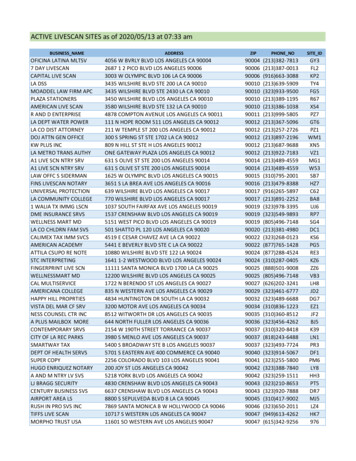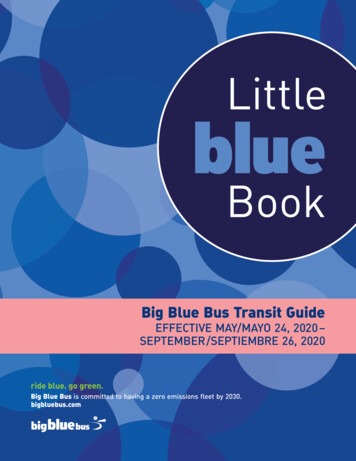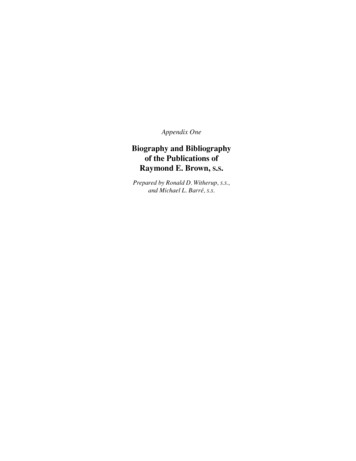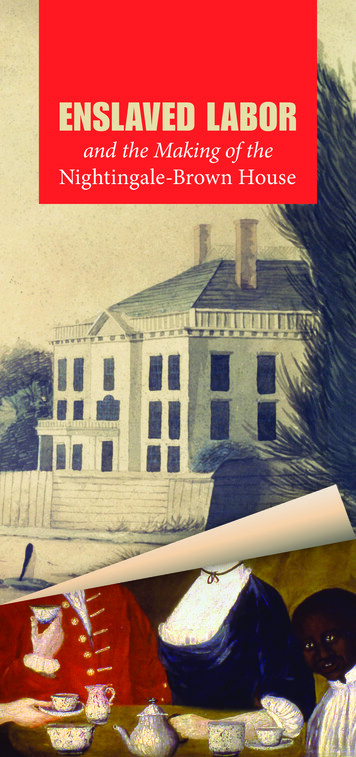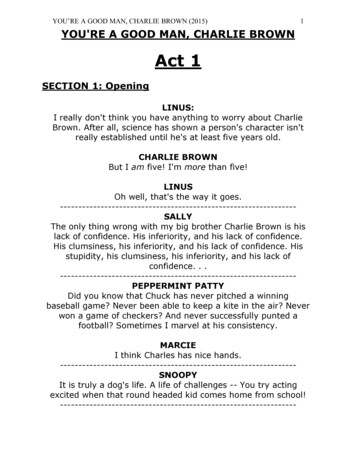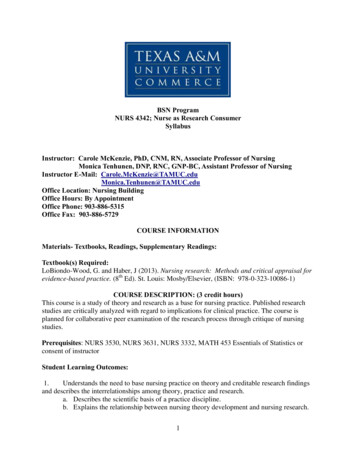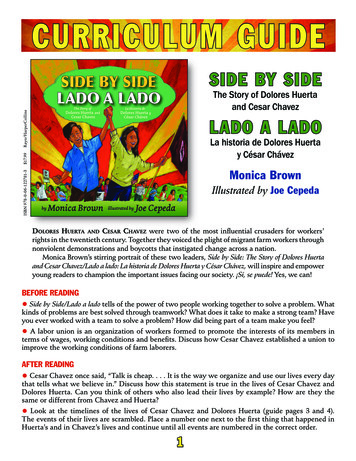
Transcription
CURRICULUM GUIDESIDE BY SIDERayo/HarperCollinsThe Story of Dolores Huertaand Cesar ChavezL ADO A L ADO 17.99La historia de Dolores Huertay César ChávezISBN 978-0-06-122781-3Monica BrownIllustrated by Joe CepedaDolores Huerta and Cesar Chavez were two of the most influential crusaders for workers’rights in the twentieth century. Together they voiced the plight of migrant farm workers throughnonviolent demonstrations and boycotts that instigated change across a nation.Monica Brown’s stirring portrait of these two leaders, Side by Side: The Story of Dolores Huertaand Cesar Chavez/Lado a lado: La historia de Dolores Huerta y César Chávez, will inspire and empoweryoung readers to champion the important issues facing our society. ¡Sí, se puede! Yes, we can!BEFORE READING Side by Side/Lado a lado tells of the power of two people working together to solve a problem. Whatkinds of problems are best solved through teamwork? What does it take to make a strong team? Haveyou ever worked with a team to solve a problem? How did being part of a team make you feel? A labor union is an organization of workers formed to promote the interests of its members interms of wages, working conditions and benefits. Discuss how Cesar Chavez established a union toimprove the working conditions of farm laborers.AFTER READING Cesar Chavez once said, “Talk is cheap. . . . It is the way we organize and use our lives every daythat tells what we believe in.” Discuss how this statement is true in the lives of Cesar Chavez andDolores Huerta. Can you think of others who also lead their lives by example? How are they thesame or different from Chavez and Huerta? Look at the timelines of the lives of Cesar Chavez and Dolores Huerta (guide pages 3 and 4).The events of their lives are scrambled. Place a number one next to the first thing that happened inHuerta’s and in Chavez’s lives and continue until all events are numbered in the correct order.1
The events in Huerta’s and Chavez’s lives are connected like a chain; each event is linked toanother. Complete the “Cause and Effect” worksheet (guide page 5) to help you better understandwhy Huerta and Chavez chose to help the cause of migrant farm workers. Many hands work to put the food on your table—from the farm workers who plant and pick thevegetables, to those who wash and prepare them for shipping, to the grocery store worker who puts themon the shelves. Complete the “Field to Table” worksheet (guide pages 6 and 7) to investigate all of thehands that help bring strawberries, lettuce, and other produce to your market for you to then buy and eat. “Where I’m From” poems describe all of the experiences that shape who people become. People aremade up of more than names, birth dates, and appearances—people are who they are because of theirexperiences and their environment. A “Where I’m From” poem might describe a student’s life as:I am from heavy text books, raising my hand in class.I am from Saturdays on soccer fields and sweet oranges at halftime.I am from the green chair in my living room, where I curl up to read my favorite book.I am from trips to the supermarket with my grandma, helping her load and unload bags ofgroceries each week.Think of all of the life experiences that helped to shape Cesar Chavez and Dolores Huerta. Individually oras a class, use facts about their lives to create poems for each leader using the “Where I’m From” pattern. Dolores Huerta is famous for saying, “¡Sí, se puede!” (“Yes, we can!”) when many farm workersdoubted that they could band together to improve their lives. Brainstorm ways that you could bringabout change in your classroom, home, and community. Have the students write “I Can” statementson strips of construction paper. Link the paper strips with “I Can” statements together to make a paperchain of change to hang in your classroom. Add more links through the year as your class thinks ofmore ideas for change. In class meetings, discuss what students are doing to make the changes listed onthe paper chain happen at home, in the classroom or in the community.LINKS Visit these websites to learn more:United Farm Workers http://www.ufw.org/Dolores Huerta Foundation http://www.doloreshuerta.org/Cesar Chavez Foundation http://www.cesarechavezfoundation.org/MONICA BROWN,Ph.D., is the author of several award-winning bilingual and multiculturalbooks, including My Name Is Celia: The Life of Celia Cruz/Me llamo Celia: La vida de Celia Cruz,winner of the Américas Award for Children’s Literature and a Pura Belpré Honor. She is a professorof English at Northern Arizona University, specializing in U.S. Latino literature and multiculturalliterature. She lives with her family in Flagstaff, Arizona. Learn more about her life and work atwww.monicabrown.net.JOE CEPEDAis the bestselling illustrator of many books for children, including Nappy Hairby Carolivia Herron and What a Truly Cool World by Julius Lester. He lives with his family inSouthern California.This curriculum guide was created by Leigh Courtney, Ph.D. She teaches first and second grade in theGlobal Education program at a public elementary school in San Diego, California. She holds both master’sand doctoral degrees in education, with an emphasis on curriculum and instruction.2
NAMETIMELINE OF CESAR CHAVEZ’S LIFENumber each event in Cesar Chavez’s life in the order in which it happened. Write “1” nextto the first event and continue numbering until all events are numbered in the correct order.a.When Cesar and his friends worked in the fields, they were hurt bydangerous tools and pesticides sprayed on the plants.b.Cesar Chavez and Dolores Huerta met and began to work together toimprove the working conditions of farm workers.c.Cesar’s family lost their home and they had to become migrant farmworkers.d.Cesar and Dolores drove from town to town to invite farm workers to joinla causa, the cause for justice.e.Cesar’s family had to move to California to follow the crops and to workin the fields.f.Cesar led farm workers on a 340-mile march to Sacramento, the capital ofCalifornia, to demand that workers be paid enough to live on.g.Cesar asked people to stop buying grapes from California because thepoisons the growers used made the farm workers sick.h.Cesar stopped eating for thirty-six days so that others would understandhow important it was to protect farm workers.ANSWERS1. c; 2. e; 3. a; 4. b; 5. d; 6. g; 7. f; 8. hSide by Side/Lado a ladoThis page may be reproduced for free distribution.3
NAMETIMELINE OF DOLORES HUERTA’S LIFENumber each event in Dolores Huerta’s life in the order in which it happened. Write “1” nextto the first event and continue numbering until all events are numbered in the correct order.a.Dolores grew up and became a teacher. She taught farm workers’ children.b.Dolores Huerta and Cesar Chavez met and began to work together toimprove working conditions for farm workers.c.Dolores Huerta was born in New Mexico.d.Dolores continues to work and march for justice for the poor.e.Dolores’ mother let farm worker families stay at her hotel for free whenthey had no place to sleep.f.Dolores moved to California with her mother and brothers. She raisedmoney for soldiers fighting in World War II.g.Dolores and Cesar drove from town to town to invite farm workers to joinla causa, the cause for justice.h.When the farm workers grew discouraged when fighting for their rightsand said, “We can’t do it,” Dolores Huerta said, “¡Sí, se puede! Yes, we can!”i.Cesar and Dolores asked people to stop buying grapes from Californiabecause the poisons the growers used made the farm workers sick.ANSWERS1. c; 2. f; 3. e; 4. a; 5. b; 6. g; 7. i; 8. h; 9. dSide by Side/Lado a ladoThis page may be reproduced for free distribution.4
NAMECAUSE AND EFFECTThe events in Dolores Huerta’s and Cesar Chavez’s lives are connected like a chain; eachevent is linked to other. Complete the boxes below to help you better understand whyHuerta and Chavez chose to help the cause of migrant farm workers.causeeffectEXAMPLE: Cesar Chavez’s familylost their home in Arizona.Side by Side/Lado a ladoThe Chavez family became migrantfarm workersThis page may be reproduced for free distribution.5
NAMEFIELD TO TABLEUsing the words in the Word Bank, list each person’s job in order near the outline of handsto show how many hands are involved in bringing food from the farm to your table.1.2.Wor d B ankGrocery Stocker3.WasherTruck DriverPickerPlanter4.Packager5.6.Side by Side/Lado a ladoThis page may be reproduced for free distribution.6
NAMEFIELD TO TABLENow look at all of the hands that work to bring you food. Discuss what difficulties the farmworkers may face in their jobs, for example: exposure to pesticides. Write about some of thechallenges the farm workers must deal with on a daily basis.Look at a grocery store flyer to see the cost of produce. Discuss the “true cost” of theproduce you eat. Record some of your thoughts below.CORRECT ORDER OF JOBS (previous page):1.Planter; 2. Picker; 3. Washer; 4. Packager; 5. Truck Driver; 6. Grocery StockerSide by Side/Lado a ladoThis page may be reproduced for free distribution.7
Discuss how Cesar Chavez established a union to improve the working conditions of farm laborers. AFTER READING Cesar Chavez once said, "Talk is cheap. . . . It is the way we organize and use our lives every day that tells what we believe in." Discuss how this statement is true in the lives of Cesar Chavez and Dolores Huerta.
